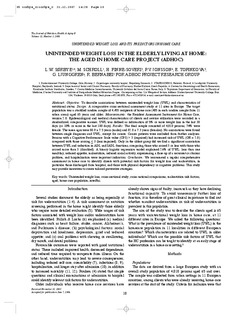| dc.description.abstract | Objective: To describe associations between unintended weight loss (UWL) and characteristics of nutritional status. Design: A comparative cross-sectional assessment study at 11 sites in Europe. The target population was a stratified random sample of 4,455 recipients of home care (405 in each random sample from 11 urban areas) aged 65 years and older.
Measurements: the Resident Assessment Instrument for Home Care, version 2.0. Epidemiological and medical characteristics of clients and service utilisation were recorded in a standardized, comparative manner. UWL was defined as information of 5% or more weight loss in the last 30 days (or 10% or more in the last 180 days).
Results: The final sample consisted of 4,010 persons; 74% were female. The mean ages were 80.9 ± 7.5 years (males) and 82.8 ± 7.3 years (females). No associations were found between single diagnoses and UWL, except for cancer. Cancer patients were excluded from further analyses. Persons with a Cognitive Performance Scale value (CPS) > 3 (impaired) had increased risk of UWL (OR = 2.0) compared with those scoring < 3 (less impaired). Only in the oldest group did we find a significant association between UWL and reduction in ADL and IADL functions, comparing those who scored 3 or less with those who scored more than 3 (disabled). A binary logistic regression model explained 26% of UWL: less than one meal/day, reduced appetite, malnutrition, reduced social activity, experiencing a flare-up of a recurrent or chronic problem, and hospitalisation were important indicators.
Conclusion: We recommend a regular comprehensive assessment in home care to identify clients with potential risk factors for weight loss and malnutrition, in particular those discharged from hospital, and those with physical dependency or cognitive problems. This study may provide incentives to create tailored preventive strategies. | en |
